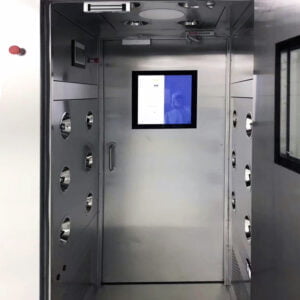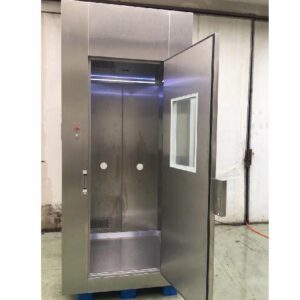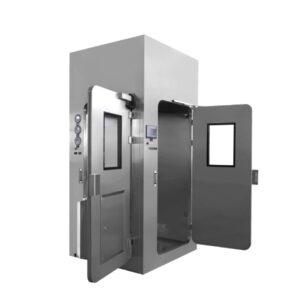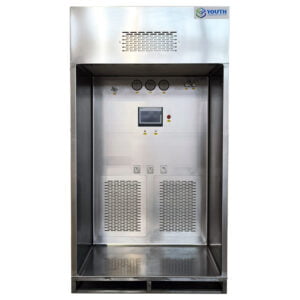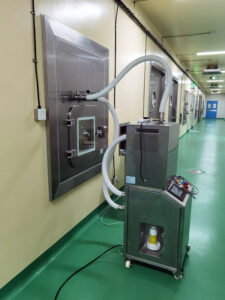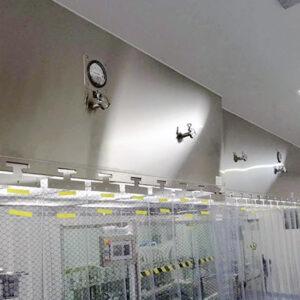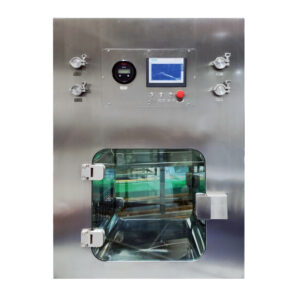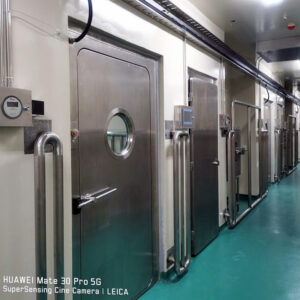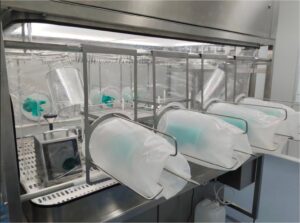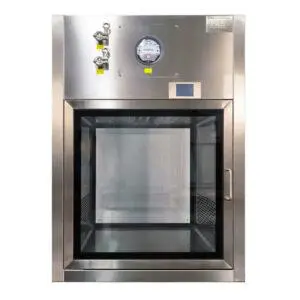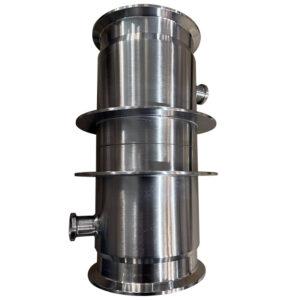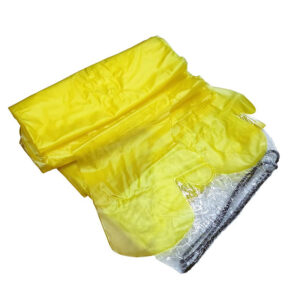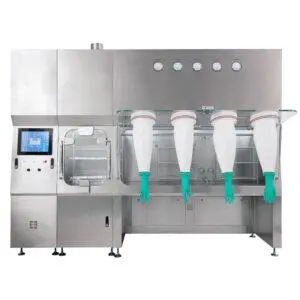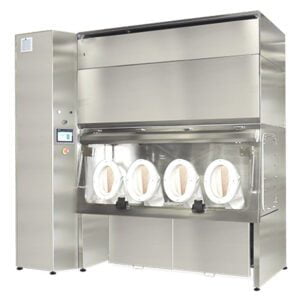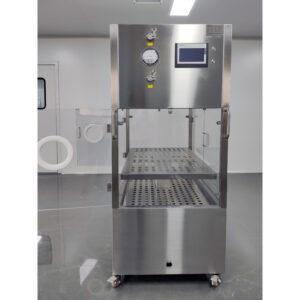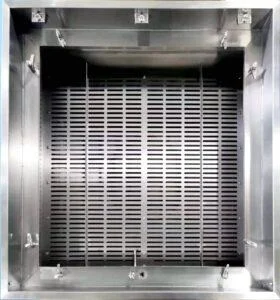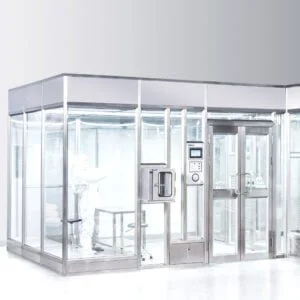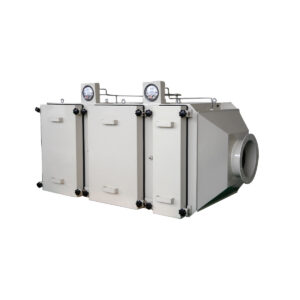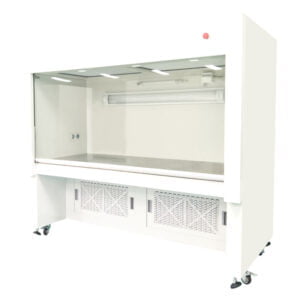Introduction
When you walk into a hospital pharmacy preparing chemotherapy drugs or step inside a biosafety laboratory handling infectious materials, you’re entering spaces where the air itself can pose serious risks. Contaminated particles escaping during filter changes, hazardous substances released into occupied areas, and compromised sterile environments represent more than operational inconveniences—they’re potential threats to patient safety, staff health, and regulatory compliance. The solution lies in a specialized technology that’s transforming how healthcare facilities manage their most critical containment challenges.
Hospital BIBO manufacturing has evolved from a niche industrial application into an essential component of modern medical infrastructure. These Bag-In-Bag-Out systems create a sealed barrier between contaminated filtration media and the surrounding environment, enabling safe filter replacement without exposure risks. Leading manufacturers like YOUTH Clean Tech have pioneered healthcare-specific designs that address the unique demands of medical facilities, where patient outcomes and regulatory scrutiny leave no room for compromise.
This comprehensive guide examines everything you need to know about healthcare BIBO containment systems—from fundamental operating principles to selection criteria, quality manufacturing standards to implementation challenges. Whether you’re a facilities manager evaluating air handling upgrades, a pharmacy director planning a compounding suite, or an infection control specialist assessing containment protocols, you’ll find actionable insights grounded in both technical specifications and real-world healthcare applications. We’ll explore why these systems have become indispensable for pharmaceutical operations, what distinguishes medical-grade manufacturing from industrial alternatives, and how facilities can navigate the complexities of installation and maintenance while maximizing protection and compliance.
What Are Hospital BIBO Systems and Why Do Healthcare Facilities Need Them?
The acronym BIBO stands for Bag-In-Bag-Out, but this simple designation conceals sophisticated engineering designed to solve one of healthcare’s most persistent safety challenges: how to remove contaminated filters from air handling systems without releasing captured hazards back into the environment. You’ve likely encountered traditional filter housings where technicians must directly handle dirty filters during replacement—a process that inevitably disperses accumulated particles, pathogens, or pharmaceutical residues into the surrounding space. BIBO technology eliminates this exposure entirely.
Understanding the BIBO Containment Principle
At its core, a BIBO system operates through a continuous sealed pathway. Filters are pre-installed inside protective bags before installation, and removal occurs by enclosing the contaminated filter within a second outer bag—hence “bag-in-bag-out.” This double-bagging methodology creates a complete containment cycle that prevents any contact between contaminated media and personnel or occupied spaces.
The containment housing itself features specialized port designs that maintain sealed connections throughout the entire change process. According to cleanroom engineering standards, properly executed BIBO procedures reduce particulate dispersion during filter replacement by 99.7% compared to traditional methods. This dramatic reduction matters profoundly in healthcare settings where even minimal contamination can compromise sterile procedures or expose staff to cytotoxic residues.
In our experience working with hospital facilities, the psychological benefit shouldn’t be underestimated. Maintenance technicians and environmental services staff gain confidence knowing they’re protected from hazardous exposures—a factor that improves compliance with scheduled maintenance and reduces operational risks associated with deferred service.
Critical Applications in Modern Healthcare Settings
Healthcare facilities deploy pharmaceutical hospital BIBO systems across numerous specialized environments. Hospital pharmacies preparing hazardous drugs represent the most common application, where USP <800> guidelines mandate rigorous containment protocols for cytotoxic materials. A 2022 study by the American Society of Health-System Pharmacists found that 73% of facilities implementing BIBO technology reported complete elimination of detectable drug residues during filter maintenance activities.
Beyond pharmacy operations, you’ll find these systems protecting:
- Biosafety laboratories handling infectious agents where filter media may contain viable pathogens
- Surgical suites and procedure rooms requiring absolute sterile conditions
- Isolation rooms for immunocompromised patients where containment prevents both ingress and egress of contaminants
- Research facilities conducting animal studies or working with potentially hazardous biological materials
- Cleanroom manufacturing areas producing sterile pharmaceuticals or medical devices
Each application presents unique containment requirements, but the fundamental challenge remains consistent: maintaining protection during the most vulnerable point in air handling operations—filter replacement. It’s worth noting that while BIBO systems excel at containment, they’re not standalone solutions. They function as critical components within comprehensive air handling architectures that also include pressure management, air change rates, and environmental monitoring.
The Evolution of Medical Containment Technology
Hospital containment technology has progressed considerably from its industrial origins. Early BIBO designs emerged from nuclear facilities and defense applications where radioactive or toxic particle containment demanded absolute security. As awareness of occupational exposure risks grew in healthcare settings during the 1990s and early 2000s, regulatory bodies began mandating stricter pharmaceutical handling protocols.
The NIOSH Alert on preventing occupational exposures to antineoplastic and other hazardous drugs, first published in 2004 and updated in subsequent years, marked a turning point. Suddenly, facilities that had relied on conventional filter housings faced clear guidance identifying these practices as inadequate. Hospital BIBO manufacturing evolved rapidly to meet healthcare-specific needs, incorporating features like:
- Stainless steel construction meeting sanitation requirements
- Compact footprints suitable for space-constrained medical facilities
- Integration capabilities with building management systems
- Documentation and validation features supporting compliance audits
- Maintenance intervals aligned with clinical operational schedules
Today’s systems represent a convergence of cleanroom technology, pharmaceutical engineering, and healthcare safety protocols. The trajectory continues toward increasingly sophisticated designs incorporating real-time monitoring, predictive maintenance capabilities, and enhanced integration with facility-wide environmental control systems.
How Do Medical Facility BIBO Equipment Protect Healthcare Environments?
The protective capabilities of healthcare BIBO containment systems extend far beyond simple physical barriers. These systems function as sophisticated air handling components that manage multiple contamination pathways simultaneously. Understanding their protective mechanisms helps you appreciate why they’ve become essential rather than optional in high-risk medical environments.
Multi-Stage Filtration Architecture
Medical facility BIBO equipment typically incorporates a cascading filtration approach with progressively finer capture efficiencies. The configuration varies based on application, but a representative hospital installation might include:
| Filtration Stage | Filter Type | Particle Capture | Primary Function |
|---|---|---|---|
| Pre-filtration | MERV 8-11 | 30-65% (1-3 μm) | Extends downstream filter life, captures gross contaminants |
| Intermediate | MERV 13-14 | 75-90% (0.3-1 μm) | Reduces particulate load, protects HEPA filters |
| Final | HEPA H13-H14 | 99.95-99.995% (0.3 μm) | Removes submicron particles, biological contaminants |
| Optional Carbon | Activated carbon | Gas/vapor phase | Removes volatile organic compounds, odors |
This staged approach serves multiple purposes. Each filtration level protects the downstream filters from premature loading, extending service intervals and reducing operational costs. More importantly for healthcare applications, the multi-barrier design provides redundant protection—if upstream filters become compromised or saturated, downstream stages continue providing containment.
The BIBO housing itself surrounds the final HEPA stage, creating a sealed chamber that contains any particles dislodged during pressure fluctuations or system operation. As industry consensus suggests, this housing containment reduces fugitive emissions from filter media by factors ranging from 10,000 to 100,000 compared to unsealed installations. When you consider that a single cubic meter of air in a contaminated work environment might contain millions of submicron particles, this containment represents the difference between acceptable and unacceptable exposure levels.
Pressure Differential Management
Beyond filtration, effective containment depends critically on proper pressure relationships. Medical grade BIBO manufacturing incorporates features that maintain negative pressure within the filter housing relative to both the contaminated exhaust stream and the surrounding mechanical space. This pressure cascade ensures that any potential leak paths draw air inward rather than releasing contaminants outward.
A typical hospital pharmacy compounding suite might operate at -0.03 inches water column relative to adjacent corridors, while the BIBO housing maintains an additional -0.01 to -0.02 inches relative to the mechanical room. These seemingly small pressure differentials create powerful protection—air naturally flows from higher to lower pressure zones, meaning contaminated air remains contained even if seal integrity is imperfect.
In our experience, facilities often overlook the relationship between BIBO systems and building pressure control. A comprehensive installation includes:
- Dedicated pressure monitoring at the BIBO housing with alarmed setpoints
- Interlock capabilities that prevent filter removal unless proper pressure differentials are confirmed
- Makeup air coordination ensuring building HVAC compensates for exhaust volumes
- Emergency bypass provisions maintaining containment even during system maintenance
One hospital we consulted implemented pressure monitoring interlocks after a near-miss incident where a technician began filter removal with inadequate pressure differential. The interlock system, which cost less than $2,000 to install, prevents housing access until pressure conditions meet safety thresholds—a relatively simple addition that provides critical protection.
Continuous Air Quality Monitoring
Modern pharmaceutical hospital BIBO systems increasingly incorporate real-time environmental monitoring that transforms them from passive barriers into active protective systems. Particle counters positioned downstream of the BIBO housing provide continuous verification of filter integrity, detecting seal failures or media breakthroughs before they compromise the protected environment.
According to data from validation studies, properly configured monitoring systems detect filter compromise an average of 27 hours before contamination reaches levels affecting critical processes. This early warning capability enables proactive maintenance rather than reactive crisis management—you can schedule filter replacements during planned downtime rather than discovering failures during production or patient care activities.
Advanced installations integrate monitoring data with building management systems, creating documentation trails that support regulatory compliance. Every filter replacement, pressure excursion, or particle count anomaly gets timestamped and recorded, providing the verification evidence that auditors increasingly expect. While these monitoring systems add to upfront costs, they typically pay for themselves within 18-24 months through avoided contamination events and streamlined compliance documentation.
What Makes Hospital Cleanroom BIBO Solutions Essential for Patient Safety?
The connection between hospital cleanroom BIBO solutions and patient outcomes might seem indirect—after all, patients rarely encounter filter housings directly. Yet the contamination pathways these systems interrupt have profound implications for clinical safety, therapeutic effectiveness, and infection control.
Contamination Prevention in Sterile Environments
Hospital cleanrooms serve environments where sterility isn’t merely desirable—it’s a regulatory requirement and clinical necessity. Compounded sterile preparations, surgical materials, and certain pharmaceutical products must meet strict bioburden limits measured in colony-forming units per specified volume or surface area. Even brief contamination incidents during filter maintenance can compromise sterility for hours or days afterward as disturbed particles settle and dispersed microorganisms find new surfaces to colonize.
A 2021 investigation by the Centers for Disease Control documented multiple outbreaks of fungal infections traced to compromised pharmacy cleanrooms. While filter maintenance wasn’t implicated in every case, the report identified “disruption of environmental controls during maintenance activities” as a contributing factor in 22% of investigated incidents. The contamination mechanism was straightforward: technicians changing conventional filters released accumulated fungal spores into the cleanroom, where they subsequently contaminated compounded preparations.
BIBO containment eliminates this contamination pathway entirely. The sealed bag-in-bag-out process prevents any particle release during filter replacement, maintaining the protected environment’s integrity throughout maintenance activities. In quantitative terms, facilities implementing BIBO systems typically demonstrate:
- Particle count excursions reduced by 94-98% during maintenance windows
- Recovery time to baseline cleanliness decreased from 4-6 hours to under 30 minutes
- Zero detectable microbial contamination associated with filter replacement activities
- Maintenance schedules no longer requiring production shutdowns or facility evacuations
These aren’t merely statistical improvements—they translate directly to enhanced patient safety through reduced infection risks and more reliable therapeutic products. It’s worth noting that BIBO systems can’t compensate for inadequate cleanroom design, poor aseptic technique, or insufficient environmental controls. They’re one critical component within comprehensive contamination control strategies.
Regulatory Compliance and Validation Requirements
Healthcare facilities operate under intense regulatory scrutiny from multiple authorities. The FDA inspects pharmaceutical compounding operations, state boards of pharmacy enforce USP chapters, and The Joint Commission evaluates environmental safety during accreditation surveys. Each regulatory body has increasingly focused on contamination control and occupational safety, making hospital BIBO manufacturing quality and validation documentation essential.
USP <797> and <800> chapters—governing sterile compounding and hazardous drug handling respectively—establish clear expectations for containment during maintenance. While they don’t explicitly mandate BIBO systems, the containment standards they define are effectively impossible to meet with conventional filter housings. USP <800> specifically requires that “all activities involving hazardous drugs… must be conducted in a manner that minimizes the risk of exposure.”
Validation presents particular challenges in healthcare settings. Unlike manufacturing facilities with dedicated validation teams, hospitals often rely on outside consultants or equipment vendors for validation services. Quality BIBO suppliers provide comprehensive validation packages including:
| Validation Component | Documentation Provided | Compliance Benefit |
|---|---|---|
| Design Qualification (DQ) | System specifications, design rationale | Demonstrates appropriate design for intended use |
| Installation Qualification (IQ) | Installation records, component verification | Confirms correct installation per specifications |
| Operational Qualification (OQ) | Performance testing at operating parameters | Validates system performs as designed |
| Performance Qualification (PQ) | Actual use testing under full operational conditions | Proves system maintains performance during real operations |
A hospital pharmacy director I spoke with recently emphasized the value of comprehensive validation documentation: “During our state board inspection, they spent nearly an hour reviewing our BIBO system validation package. Having complete documentation from the manufacturer made the difference between a clean survey and a deficiency citation.”
Integration with Existing Infrastructure
You can’t simply bolt a BIBO housing onto an existing air handling system and expect optimal performance. Effective healthcare BIBO containment systems require thoughtful integration with ductwork, pressure controls, and facility operations. The integration challenges vary significantly based on whether you’re incorporating BIBO into new construction or retrofitting existing facilities.
New construction offers obvious advantages—ductwork can be sized appropriately, mechanical spaces can accommodate housing dimensions, and electrical/control infrastructure can be specified with BIBO requirements in mind. The additional cost for BIBO-ready design typically adds only 5-8% to comparable conventional installations.
Retrofit projects present greater complexity. Existing mechanical spaces may lack adequate clearance for BIBO housing access, ductwork configurations might not align with optimal housing placement, and older building management systems may not support integration with BIBO monitoring and control features. Successful retrofits typically require:
- Detailed site surveys identifying space constraints and access requirements
- Custom housing configurations adapting standard designs to specific installation conditions
- Temporary containment provisions maintaining protection during installation
- Phased commissioning approaches minimizing disruption to ongoing clinical operations
While retrofit costs exceed new construction installations by 40-60%, facilities generally find the investment justified. One surgical center retrofitted five air handling systems with BIBO housings at a total project cost of $127,000. Within 16 months, they recovered those costs through avoided production shutdowns, reduced contamination incidents, and decreased insurance premiums following risk assessment improvements.
How to Choose the Right Healthcare BIBO Containment Systems?
Selecting appropriate medical facility BIBO equipment requires balancing multiple technical specifications, operational factors, and budget constraints. Unlike commodity purchases where price comparison drives decisions, BIBO system selection demands careful evaluation of long-term performance, compliance capabilities, and total cost of ownership.
Assessing Your Facility’s Specific Needs
Start by documenting your containment requirements comprehensively. Different healthcare applications demand different BIBO configurations, and over-specifying wastes budget while under-specifying creates compliance risks. Consider these critical factors:
Hazard characteristics: Are you containing pharmaceutical residues, infectious agents, radioactive materials, or general particulate? Cytotoxic containment requires different sealing mechanisms than biosafety applications. Systems handling infectious agents often incorporate additional features like automated bag sealing and double-door pass-through designs that pharmaceutical applications may not require.
Airflow volumes: BIBO housings are rated for specific maximum airflow capacities, typically ranging from 400 to 2,000 cubic feet per minute (CFM) for healthcare applications. Under-sizing creates excessive pressure drop and reduced system performance; over-sizing wastes budget and mechanical space. Calculate actual exhaust volumes under peak load conditions—not just nominal design airflow—to ensure adequate capacity.
Filter dimensions and types: BIBO housings must accommodate specific filter sizes. Standard healthcare configurations accept 12x24x12, 24x24x12, or 24x24x6 inch HEPA filters, but custom sizes require custom housings at premium cost. If your existing air handling system uses non-standard filters, you’ll need to factor housing customization into your budget.
Space constraints: Measure available mechanical room space carefully, accounting for required clearances. Filter replacement requires access to the bagging ports—typically 36-48 inches of clearance. Ceiling height limitations may necessitate horizontal rather than vertical housing orientations.
In our experience, facilities benefit enormously from involving maintenance technicians in the selection process. The people who’ll actually perform filter changes can identify practical challenges that specifications sheets don’t reveal. One hospital avoided a problematic installation after their lead technician noted that the initially selected housing would require standing on ductwork to access bagging ports—an unsafe configuration that specification reviews hadn’t flagged.
Capacity and Scalability Considerations
Healthcare facilities evolve—new clinical programs emerge, regulatory requirements change, and patient volumes fluctuate. Your BIBO system selection should anticipate these changes rather than locking you into rigid configurations. Look for designs offering:
Modular expansion capabilities: Some manufacturers offer housing families where smaller units can be field-upgraded to higher capacities through filter frame replacements rather than complete housing changeouts. This modularity provides growth pathways without wholesale system replacement.
Multiple pressure rating options: Facilities sometimes convert spaces to different uses—a pharmacy compounding area might become a biosafety laboratory, or vice versa. BIBO housings designed for adjustable pressure differentials adapt more readily to changing requirements.
Filter media flexibility: Systems accepting multiple filter efficiency grades (HEPA H13, H14, or ULPA) without housing modifications provide operational flexibility as contamination control requirements evolve.
A comparative cost analysis illustrates scalability value:
| Approach | Initial Cost | 10-Year Total Cost | Flexibility Rating |
|---|---|---|---|
| Fixed capacity system | $12,000 | $34,500 | Low – limited to initial specifications |
| Modular system with upgrade pathway | $14,500 | $31,200 | High – adapts to changing needs |
| Over-specified system “growing into” | $18,000 | $42,800 | Medium – excess capacity costs persist |
The modular approach costs 20% more initially but delivers 10% lower total ownership costs while providing operational flexibility that fixed systems can’t match. You’re essentially buying options value—the ability to adapt without major capital expenditures when requirements change.
Certification and Quality Standards
Not all BIBO manufacturers maintain equivalent quality standards, and healthcare applications demand more rigorous specifications than many industrial suppliers provide. When evaluating vendors, verify these essential quality indicators:
ISO cleanroom manufacturing certification: Reputable hospital BIBO manufacturing occurs in controlled environments meeting ISO 14644 cleanroom standards. Manufacturing HEPA filter housings in contaminated facilities defeats their purpose—particles embedded during production compromise initial cleanliness and potentially create ongoing contamination sources.
Material certifications: Medical-grade stainless steel (typically 304 or 316L) resists corrosion from cleaning agents and provides surfaces compatible with healthcare sanitation protocols. Some suppliers substitute less expensive materials that degrade under repeated disinfection, creating maintenance burdens and potential contamination harboring points.
Third-party testing documentation: Quality manufacturers provide independent test reports verifying housing integrity, seal performance, and pressure ratings. Be skeptical of suppliers offering only their own internal test data—third-party verification from recognized testing laboratories provides credible assurance.
Validation support services: Leading suppliers don’t just ship equipment—they provide comprehensive commissioning support, validation protocol templates, and ongoing technical assistance. This service component becomes invaluable during regulatory inspections when auditors question system performance or documentation.
I’ve reviewed procurement specifications from dozens of hospitals, and the most successful installations consistently involved vendors offering complete validation packages. One facility saved an estimated $18,000 in consulting fees and six weeks of project schedule by selecting a supplier providing turnkey validation support rather than the lowest-cost equipment bid requiring independent validation services.
What Are the Key Features of Pharmaceutical Hospital BIBO Systems?
The distinction between industrial BIBO equipment and pharmaceutical hospital BIBO systems lies in design features specifically engineered for healthcare contamination control and pharmaceutical manufacturing requirements. These features reflect accumulated learning from decades of pharmaceutical processing and evolving regulatory expectations.
Advanced Filter Housing Design
Pharmaceutical-grade BIBO housings incorporate sophisticated design elements that extend far beyond simple containment boxes. The housing geometry itself influences contamination control effectiveness and operational reliability.
Smooth interior surfaces: Healthcare-grade housings feature continuously welded seams and radius corners that eliminate crevices where particles accumulate. Industrial units often have bolted assemblies and sharp corners that create cleaning challenges and potential contamination reservoirs. The difference matters profoundly in pharmaceutical applications where residual contamination from one batch can cross-contaminate subsequent production.
Sealed penetrations: Every port, gauge connection, and control cable penetration represents a potential leak path. Quality pharmaceutical housings feature gasketed penetrations with documented leak rates typically below 0.01% of system airflow. Testing involves pressurizing the housing and measuring air leakage—specifications should guarantee specific maximum leak rates rather than vague “tight seal” claims.
Pressure relief provisions: Unexpected pressure excursions during filter installation or system start-up can compromise bag seals or even damage housing components. Engineered pressure relief mechanisms—typically spring-loaded valves or rupture discs—protect against overpressure while maintaining containment. These safety features operate at predetermined thresholds, preventing damage without creating exposure risks.
Material compatibility: Pharmaceutical facilities use aggressive cleaning and disinfection agents. Housing materials must resist degradation from repeated exposure to isopropyl alcohol, bleach solutions, hydrogen peroxide vapors, and other sanitizing agents. Inferior materials show corrosion, seal degradation, and surface pitting within 2-3 years, while pharmaceutical-grade stainless steel maintains integrity for 15-20+ years.
It’s worth noting that pharmaceutical design features typically add 30-45% to housing costs compared to industrial equivalents. Facilities sometimes question this premium, but the performance differences justify the investment. A hospital that initially purchased lower-cost industrial housings spent $23,000 replacing them after only four years when corrosion and seal failures created recurring containment issues—ultimately spending more than pharmaceutical-grade units would have cost initially.
Safe Filter Replacement Mechanisms
The entire purpose of BIBO technology centers on safe filter replacement, making the bag interface mechanism the system’s most critical component. Hospital cleanroom BIBO solutions employ sophisticated bagging procedures that maintain absolute containment throughout the change process.
The standard replacement procedure involves:
- Pre-bagging: Clean filters arrive pre-installed in sealed plastic bags that remain in place during installation
- Filter installation: The bagged filter assembly installs into the housing through sealed ports
- Bag removal after installation: Once secured, the clean filter’s outer bag is carefully removed, leaving the filter in place
- Filter operation: The system operates normally with the filter now protecting the space
- End-of-life bagging out: When replacement is needed, a technician inserts arms through port sleeves and places a disposal bag around the contaminated filter
- Seal and removal: The disposal bag is sealed while still inside the housing, then the entire assembly is removed without any exposure
This procedure seems straightforward in description but requires precise execution. Quality BIBO housings incorporate design features that make proper technique easier and failure less likely:
- Ergonomic port positioning that allows natural hand positions and movements
- Clear visibility into the housing during bagging operations
- Intuitive filter frame latches operable while wearing bulky gloves
- Bag retention features preventing premature bag displacement during sealing
- Foolproof orientation making it obvious when filters are correctly positioned
Training remains essential—even well-designed systems require proper technique. Facilities should budget for initial training during installation and annual refresher sessions for maintenance staff. One surgical center documented that technicians who received annual hands-on BIBO training completed filter changes 40% faster and with zero contamination incidents compared to those who received only initial training.
Material and Construction Specifications
The materials and construction methods used in medical grade BIBO manufacturing directly impact long-term performance, maintenance requirements, and total cost of ownership. Detailed specifications matter more than you might initially assume.
Stainless steel grade and finish: Type 304 stainless provides adequate corrosion resistance for most healthcare applications, while Type 316L offers superior resistance in highly corrosive environments or coastal facilities. Surface finish matters equally—2B finishes (smooth but not polished) provide optimal balance between cleanability and cost, while rougher mill finishes create cleaning challenges and polished finishes add cost without performance benefits.
Gasket materials: Seal integrity depends critically on gasket compound selection. Neoprene works well for general applications, silicone offers superior temperature tolerance, and EPDM provides excellent chemical resistance. Some pharmaceutical applications require FDA-compliant gasket materials documented with drug master files—a requirement that eliminates many common gasket compounds.
Weld quality: Continuously welded housings outperform mechanically fastened alternatives, but weld quality varies significantly. Look for specifications requiring ASME BPE (Bioprocessing Equipment) welding standards, which mandate specific procedures for pharmaceutical equipment. Quality welds are smooth, consistent, and completely penetrating—not just surface beads that look acceptable but lack structural integrity.
Coating options: Some manufacturers offer powder coating or specialty surface treatments. For pharmaceutical applications, these coatings must be validated for use in cleanroom environments and compatible with pharmaceutical cleaning agents. Unvalidated coatings can flake or degrade, creating particle contamination sources that defeat the BIBO system’s purpose.
A detailed material specification table from a recent hospital procurement illustrates the documentation level quality installations require:
| Component | Material Specification | Certification Required | Notes |
|---|---|---|---|
| Housing body | 304SS, 2B finish, 14 gauge minimum | Mill test report | Continuously welded per ASME BPE |
| Filter frame | 304SS, 2B finish | Mill test report | Spring-loaded seal compression |
| Bag ports | Clear polycarbonate or acrylic | Material certification | UV-resistant grade |
| Gaskets | Silicone, FDA compliant | FDA drug master file | Temperature range -40°F to 400°F |
| Hardware | 316SS | Material certification | All fasteners and latches |
| Bag material | 6 mil polyethylene minimum | – | Anti-static formulation |
This specification level might seem excessive, but pharmaceutical applications demand this documentation rigor. During regulatory inspections, you may need to demonstrate material traceability and compliance—”we bought a BIBO system” doesn’t satisfy auditors, while comprehensive material certifications do.
How Does Medical Grade BIBO Manufacturing Impact Quality Standards?
The quality of hospital BIBO manufacturing directly influences system performance, regulatory compliance, and operational reliability. Manufacturing in ISO-certified cleanrooms using validated processes creates fundamentally different products than fabrication in conventional industrial environments. Understanding these manufacturing quality factors helps you evaluate suppliers and make informed procurement decisions.
ISO Cleanroom Production Requirements
Reputable BIBO manufacturers produce equipment in controlled environments meeting ISO 14644 cleanroom standards—typically ISO Class 7 or 8 (equivalent to Class 10,000 or 100,000 in older terminology). This controlled production environment isn’t marketing showmanship; it delivers measurable product quality advantages.
Cleanroom manufacturing prevents particle contamination during production. A BIBO housing fabricated in an uncontrolled shop accumulates substantial particulate burden from grinding operations, welding fume, ambient dust, and handling. These particles embed in surfaces, lodge in joints and gaskets, and create initial contamination that compromises early system performance. Facilities have documented contamination incidents traced to particles shed from newly installed equipment manufactured in uncontrolled environments.
Beyond particle control, cleanroom manufacturing enforces process discipline that correlates with overall quality. Facilities maintaining ISO cleanroom certification implement:
- Documented procedures for all manufacturing operations
- Material controls verifying incoming component quality
- Process validation confirming manufacturing steps produce consistent results
- Environmental monitoring detecting process deviations before they affect products
- Trained personnel understanding contamination control principles
According to a pharmaceutical industry quality survey, equipment manufactured in ISO-certified cleanrooms showed 87% fewer field failures during the first two years of operation compared to similar equipment from non-certified facilities. This reliability difference translates directly to reduced maintenance costs and fewer disruptive failures during critical operations.
Testing and Validation Protocols
Quality manufacturers subject completed BIBO housings to comprehensive testing before shipment. These factory acceptance tests (FAT) verify performance against specifications and identify any manufacturing defects before equipment reaches your facility. Standard testing protocols include:
Pressure decay testing: The housing is sealed and pressurized to operating pressure plus a safety margin (typically 1.5x to 2x operating pressure). Pressure is monitored over 15-30 minutes to verify leak rates fall within acceptable limits. This test confirms seal integrity and housing structural soundness.
Filter integrity scanning: HEPA filters undergo DOP (dioctyl phthalate) or PAO (polyalphaolefin) aerosol testing that challenges the media with submicron particles while downstream sensors scan for penetration. This testing verifies both media integrity and seal effectiveness between filter frames and housing.
Airflow uniformity: Multiple measurement points verify even airflow distribution across the filter face. Non-uniform flow indicates seal leaks, flow obstructions, or design problems that reduce effective filtration area.
Functional testing: All latches, ports, and operational features are cycled through complete operational sequences verifying proper function.
Comprehensive testing adds 8-12% to production costs but eliminates the far greater expenses of field troubleshooting and corrections. One hospital received a BIBO system that consistently failed pressure decay tests after installation. Weeks of troubleshooting eventually traced the problem to a manufacturing defect—a pinhole weld penetration invisible to visual inspection. Had the manufacturer performed pressure testing before shipment, they would have caught the defect during
Related Contents:
- HEPA Housing Boxes in Pharmaceutical Manufacturing: Uses
- Hospital HVAC Systems: HEPA Housing Box Implementation Guide
- Bag-In/Bag-Out (BIBO) Systems: Operation and Maintenance Guide
- The Intricate World of BIBO Filter Housing
- Understanding BIBO | Hazardous Material Containment
- Bag In Bag Out Systems | Safety Fundamentals Explained
- BIBO Filter Housing | Design Principles & Components
- BIBO System Basics | Bag In Bag Out Filter Principles
- Ultimate Guide to HEPA Housing Boxes: Applications & Benefits



